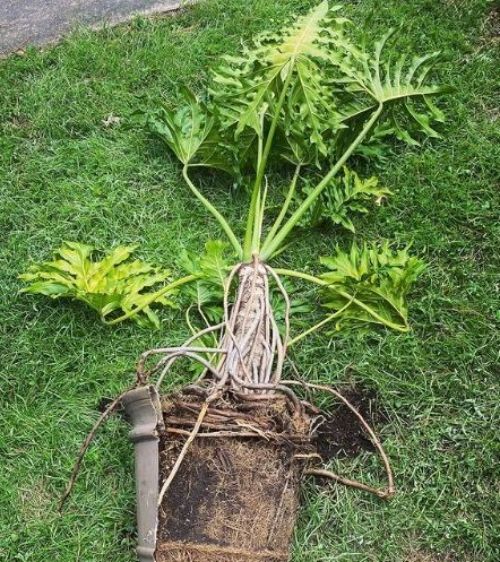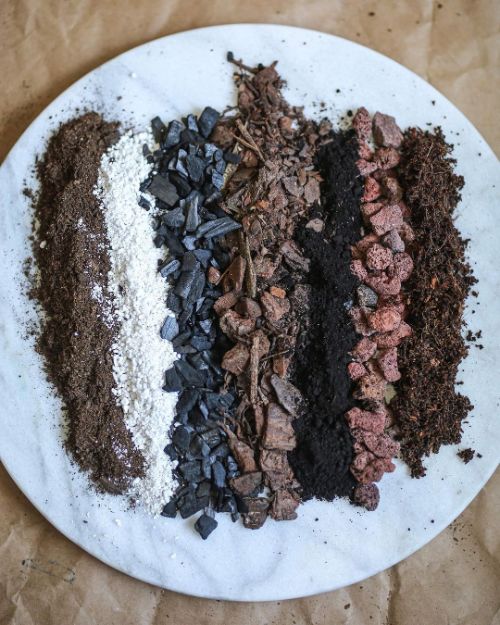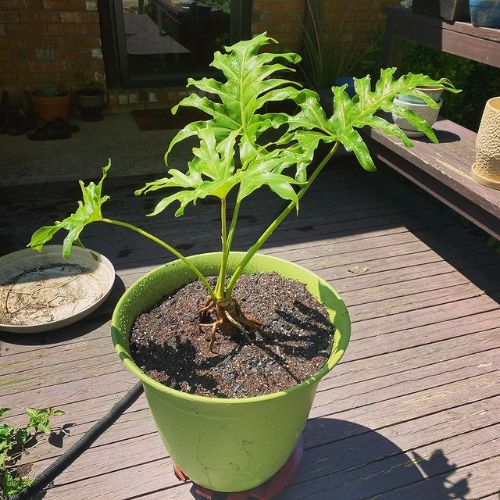Repotting is a must-do job for maintaining the health of your loved leafy pals. In this article, we’ll guide ya on how to repot a philodendron, step-by-step, share tips on when and how often to repot, discuss things to watch out for during repotting and share tips on lookin’ after your repotted leafy friend. Whether you’re a pro plant lover or a beginner, this guide will equip you with the knowledge and skills to make sure your philodendrons are happy in their new homes.
Reasons to Repot Your Philodendron
Repotting a philodendron is not only a refreshing task but also a great thing for the plant’s overall health and growth. Here are several reasons why repotting your philodendron is recommended:
- Promotes Plant Multiplication: Philodendrons are highly popular because they look great, making lots of plant lovers want more of them in their living spaces. Repotting gives you a chance to grow new plants from existing ones, expanding your philodendron collection.
- Addresses Mineral Loss: Philodendrons rely on the goodies in the soil to grow well. But, over time (around 1 to 2 years), the soil slowly loses its mineral content, making it not so good for new growth. Repotting lets you top up the soil with fresh nutrients, making sure they grow healthy.
- Prevents Excessive Root Binding: Philodendrons hate being root-bound, as it can lead to bacterial growth, root rot, and hinder overall plant development. As long-living heartleaf philodendrons grow, they need repotting to give lots of room for root expansion and prevent the bad effects of root binding.
- Facilitates Growth: Repotting helps growth, a main concern for most philodendron owners. When the roots get crowded and start circling the pot’s bottom, poking out of the soil or creeping through drainage holes, it shows root binding. By repotting, you give the plant more space for both root and top growth. It also lets you untangle tied-up roots, improving water and nutrient uptake.
- Improves Soil Quality: Over time, the soil in the pot breaks down, impacting the plant’s growth. The structure of the soil falls apart, leading to squishing in some areas and reduced water retention in others. Also, nutrients slowly wash out of the soil during watering, making it less fertile. Repotting every 3-4 years (or 2-3 years for smaller pots) with fresh soil makes the plant’s root environment young again, ensuring the best nutrient availability and water retention.
- Controls Pests and Diseases: Despite best efforts to keep a pest- and disease-free environment, philodendrons might run into problems like fungus gnats, mold, or root rot. Repotting is key in fixing soil-borne problems or stopping their spread. Pests and diseases often hang out in the soil, and repotting lets you totally replace soily soil, fixing the problem effectively. It also lets you look closer at the roots to take out any damaged bits and prevent more problems.
- Enables Propagation: Repotting gives a chance for propagation, a fun gardening job that lets you grow more of your favorite philodendrons at no extra cost. While cuttings are a popular method, division can also be used for bushy and lush plants. By splitting up the roots and stems into smaller clumps and repotting them, you can grow lots of plants from a single philodendron.

By considering these reasons, you can make smart choices about when and why to repot your philodendron, ensuring its continued health and vitality.
When and How Often Should I Repot Philodendron?
Knowing the best time and how often to repot is super important for the well-being of your philodendron. Here’s what you need to consider:
Signs It’s Time to Repot
- Root Bound: Check for roots circling the bottom of the pot, coming out of the drainage holes, or pushing the plant upwards.
- Slow Growth: If your philodendron isn’t growing a lot despite good care, it might need more space.
- Water Drainage Issues: Trouble with water soaking in or too much water pooling on the soil surface can show compacted roots.
Repotting Frequency
- Young Philodendrons: Repot every 1-2 years to keep up with their growth and make sure they have good root growth.
- Mature Philodendrons: Repot every 2-3 years or when you see signs of root cramming.
How to Repot A Philodendron?
Philodendrons are tough and easy-going houseplants. But sometimes, they gotta be moved to a bigger pot to fit their growth.
Before we can repot the philodendron, we gotta get these tools ready:
- New Pot: Grab a pot that’s one size bigger, with drainage holes for the water to flow through.
- Fresh Potting Mix: Go for soil that drains well with a mix of peat moss, perlite, and vermiculite.
- Gloves: Keep your hands safe during the repotting process.
- Watering Can or Spray Bottle: You’ll need this to water the philodendron after repotting.

Then, just follow these 6 simple steps to repot your Philodendron effectively:
- Step 1: Carefully take the Philodendron out of its current pot
The first step to repotting your Philodendron is to get it out of its current container. If the plant is in a plastic pot, gently squeeze the edges to loosen the soil and lift the plant out. If it’s in a ceramic or terracotta pot, slowly rotate the plant and give it a gentle tug to free it. - Step 2: Root Maintenance
Start by carefully untangling the roots with clean tools like a fork or chopsticks. Rinse them under tap water for a thorough cleanse and to help in loosening the roots. To keep the plant healthy, use sterilized scissors to cut away any sick or rotting roots. - Step 3: Trimming Back Leaves
Before moving your Philodendron into its new home, give it a bit of a prune. Removing some mature leaves will help the plant focus its energy on establishing its roots in the new environment, fostering better overall growth. - Step 4: Preparing the Perfect Potting Mix
A potting mix with coco peat, perlites, and sand is great for Philodendrons. Or, a standard, sterilized potting mix from a plant store can work just as well. Sphagnum peat moss is also a good fit for Philodendrons, as is a peat-vermiculite or peat-perlite mix. Whichever you choose, start by filling one-third of the new pot with your potting mix. - Step 5: Placing the Philodendron in the new pot and throwing in more potting mix
Next, gently place your Philodendron in its new pot, making sure the roots face downwards or sideways. Then, add more potting mix to hold the plant upright. - Step 6: Thoroughly Watering the Repotted Philodendron
Lastly, water your newly repotted Philodendron generously until water seeps out from the drainage holes. Place it in a shady spot for a week, keeping the soil moist but not too wet.
Learn more about how to repot a philodendron by watching this video:
Precautions During the Repotting Philodendron
Even though Philodendrons are pretty easy to repot, you need to be careful not to hurt the plant.
1. Handle with Care Try not to hurt the delicate stems and leaves when taking the plant out of its current pot.
2. Use Clean Tools: Make sure your tools are clean and sanitized to avoid spreading diseases or pests.
3. Avoid Overwatering: While water is important for the plant’s health, too much can lead to root rot. Water the plant after repotting but avoid too much moisture. If the roots and soil seem compact, give the plant a good drink before trying to repot.
4. Pruning: If your Philodendron isn’t growing much, trim the plant back to four inches to get it growing healthier. Don’t cut more than 50% of the roots at a time and never remove more than 75% of the leaves in one go.
5. Use gloves: Always put on gloves while handling Philodendrons ’cause their sap can irritate the skin.
Related: Best Pot For Philodendron: Perfect Choosing For Optimal Growth
Post-Repotting Care of Your Philodendron
After repotting your Philodendron, you need to make sure you’re giving it the right care to help the plant get used to its new home. Here are some key care tips to make sure your Philodendron does well after the repotting process.
- Light and Location: Philodendrons do well in a semi-light, shady spot after repotting. If you’re keeping them outdoors, a balcony with not much direct sunlight is perfect. Indoors, put your Philodendron near a south or east-facing window, but protect it from strong light with sheer curtains.
- Temperature Regulation: Try to keep the temperature during the day between 65ºF and 80ºF, and around 60ºF at night. Keeping the temperature steady is important for the plant’s well-being.
- Watering and Humidity: Don’t water it too much and keep the soil slightly moist with daily misting. But to avoid fungus growth, wipe the plant after each misting. The perfect humidity is between 65% to 80% during the day, and you can lower it to about 55% at night.
- Pest Control: Watch out for signs of aphids, mealybugs, scales, and spider mites. You can manually remove these pests or spray the plant with neem oil every three days.
- Fertilization: Don’t use water-soluble fertilizers for at least six weeks after repotting. But you can use organic and natural fertilizers safely in the third week.
- Immediate Post-Repotting Care: Water your Philodendron right after repotting to help it adjust and stimulate new root growth. Ideally, put the plant back where it was to avoid more stress from environmental changes.
Keep an eye on your Philodendron for signs of stress like leaves turning yellow or wilting. Minor issues should fix themselves in a few weeks.
Try not to change how you take care of it during this time ’cause it could make things worse. If problems don’t go away after a month, it’s a good idea to figure out what’s causing them and take the right steps to fix them.

Common Mistakes in the Repotting Process
While repotting your Split Leaf Philodendron, it’s important to avoid certain common mistakes to ensure the well-being and growth of your plant. Here are three typical screw-ups and how to dodge them:
Inadequate Soil Drainage
Philodendrons need well-drained soil to cut down the risk of root rot and other water-related problems. Crappy soil drainage can make your soil waterlogged, lead to root rot, fungal diseases, and mess with growth.
To confirm adequate soil drainage:
- Mix a good potting mix that includes peat moss, perlite, or coarse bark.
- Put a layer of drainage stuff like gravel or broken pottery at the bottom of the pot.
- Make sure your pot has drainage holes. Don’t go for pots without them.
Overpotting
This happens when the pot you pick is way too big for the plant. Potting in too big pots can have a bunch of bad effects including potential root rot, not enough air for the roots, lower growth due to the larger soil volume.
To avoid this, pick a pot only slightly bigger than the previous one, ideally 2-4 inches wider in diameter.
Disregarding Root Health
Not checking the root system is another common repotting mistake. Not seeing signs of root damage or disease could cause lasting problems. Therefore, during repotting:
- Check the roots for any signs of rot or damage.
- Loosen compacted or bound roots gently to stimulate growth.
- Remove any dead or damaged roots before replanting.
Conclusion
Getting how to repot a Philodendron is super important for keeping your plant healthy and growing. From figuring out the need to repot, the right timing, the repotting steps, and aftercare, to dodging common mistakes, the guide of FamiPlants is your reliable guide to making sure your Philodendron thrives in its new home. Remember, good repotting can really boost your plant’s life and health.

